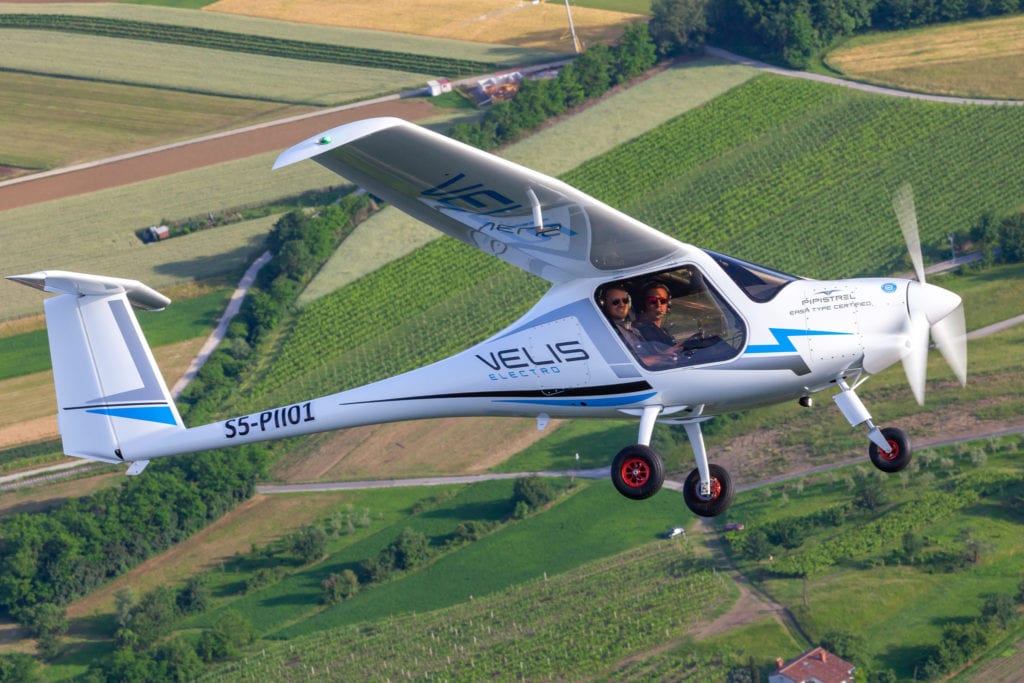
On June 10, Pipistrel’s Velis Electro received the first type certification for an electric aircraft from EASA, a major milestone for electric aviation. (Pipistrel)
Pipistrel’s two-seat Velis Electro was awarded type certification by the European Union Aviation Safety Agency (EASA) on June 10, the first electric aircraft in the world to do so.
Derived from the Slovenian light aircraft manufacturer’s Virus SW 128, the Velis Electro is designed to be a trainer aircraft, with 1,320 lbs maximum takeoff weight, 100 mph cruise speed and 50 minutes of endurance plus reserves. It’s powered by Pipistrel’s E-811-268MVLC electric engine, which was certified by EASA on May 18.
“The type certification of the Pipistrel Velis Electro is the first step towards the commercial use of electric aircraft, which is needed to make emission-free aviation feasible. It is considerably quieter than other aeroplanes and produces no combustion gases at all,” said Ivo Boscarol, founder and CEO of Pipistrel Aircraft. “It confirms and provides optimism, also to other electric aircraft designers, that the Type Certificate of electric engines and aeroplanes is possible.”
According to Pipistrel, the Velis Electro’s built-in continuous health and monitoring system enhances its reliability, allowing the airplane to have “more than double the lifespan of powertrain elements in comparison to the previous generation of electric aeroplanes.”

The cockpit of Pipistrel’s Velis Electro. Photo: Pipistrel
“It should also be noted that this innovative product was, despite the many challenging aspects, certified in less than 3 years, showing the excellent work performed by Pipistrel and the EASA teams,” said Dominique Roland, head of the general aviation department at EASA. “Finally, it is worth mentioning that the certification team was composed of EASA staff, but included experts from the Swiss and French authorities, in order to prepare and facilitate the entry into service of the Velis Electro in these two countries.”
Pipistrel plans to deliver 31 Velis Electros in 2020 to customers in seven different countries.
AlpinAirPlanes, the Switzerland-based launch customer, plans to initially distribute 12 aircraft on 10 airfields across the country.

According to Pipistrel, one battery pack is located in the nose of and the second behind the cabin. This ensures redundancy of the power source: in case of battery failure, the malfunctioning battery would get automatically disconnected from the system. A single battery is capable of standalone operation and has enough power capability to support climbing and continuation of flight. Photo: Pipistrel
“Each base will be equipped with 150 m2 of photovoltaic panels, producing electricity for 12,000 flight hours per year on the Velis Electro,” said Marc Corpataux of AlpinAirPlanes. “We are happy to offer the most environmentally friendly training possible.”
Pipistrel’s achievement is a significant milestone for electric aviation. In the United States, Bye Aerospace was targeting type certification from the Federal Aviation Administration for its two-seat eFlyer 2 by late 2021, though that timeline is likely to slip due to the COVID-19 pandemic. The eFlyer 2 is also intended for use as a training aircraft, though at least one company — Quantum XYZ — intends to use it for regional airline services.
And last month, magniX and AeroTEC successfully flew an all-electric Cessna 208B Grand Caravan for 30 minutes. MagniX hopes to receive FAA certification for its 750-hp Magni500 propulsion system by the end of 2021 as well.